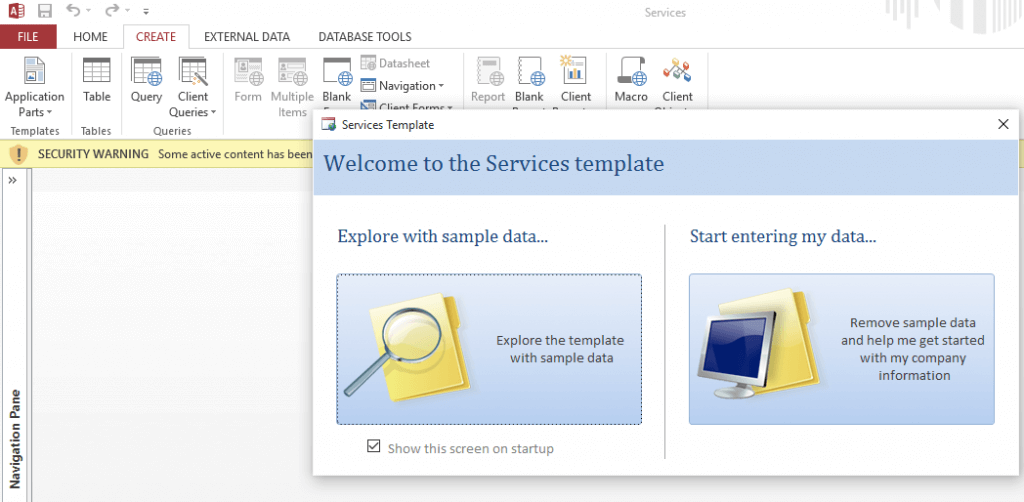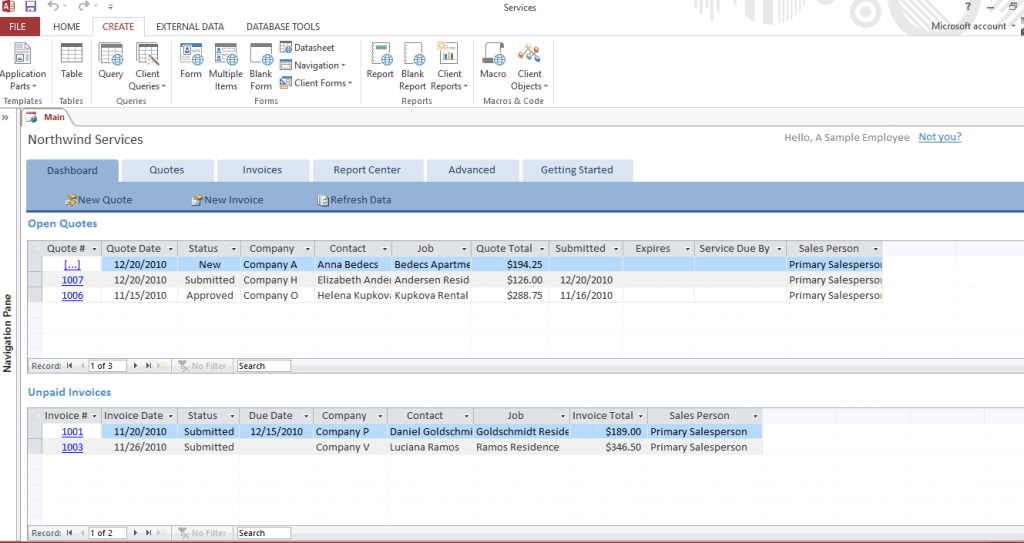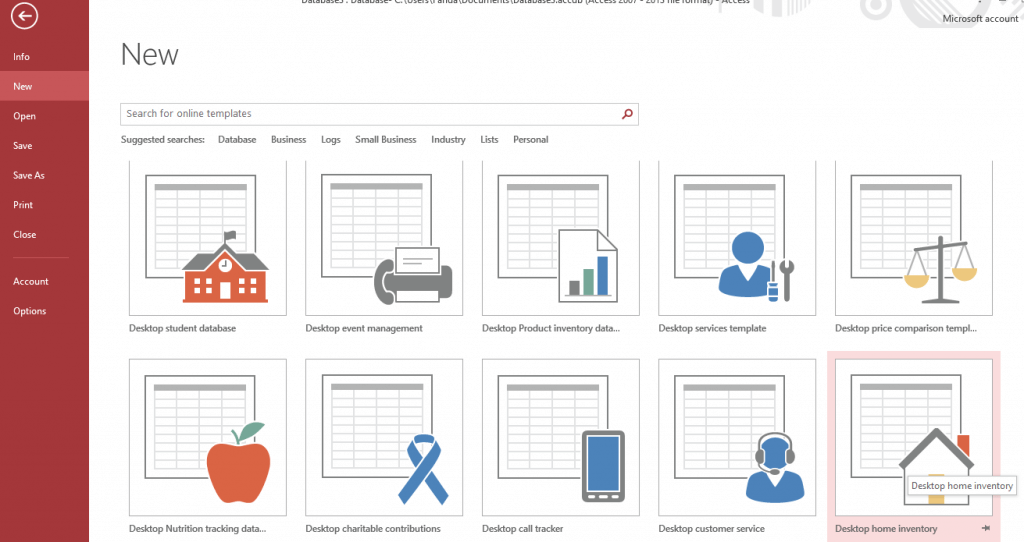Microsoft Access Features;
- Ideal for individual users and smaller teams
- Easier than client-server database to understand and use
- Import and export to other Microsoft Office and other applications
- Ready templates for regular users to create and publish data
- Allows building and publishing Web databases effortlessly
- A user friendly feature ‘Tell Me’ for assistance
- Allows developers to create custom solutions using VBA code
- Hide/Show option for Ribbon
- Allows users to Report View Eliminates Extra Reports
- Allows output Reports in PDF format
Ideal for individual users and smaller teams
Microsoft Access is a simple desktop application that does not require any specific hardware or license to function. Hence, it is ideal for individual users and smaller teams who do not require larger and complicated data bases for extra price.
Microsoft Access offers numerous advantages over database solutions over SQL Server and Oracle where the need for database is not very high. Many smaller teams can now avoid purchase of massive resource for their basic and simple needs with the help of Microsoft Access.
Further, they do not need anyone to administer or monitor Access which may be required by regular client-server databases.
Moreover, it comes with an option of allowing users to turn their database into application, which was introduced after Microsoft Access 2007.
Is easier than client-server database to understand and use
Personal computer applications like Microsoft Access have taken over many applications which were earlier relegated to client-server database in the past. Users of Access need not undergo any special training to acquire the skills necessary to use the application.
Many users have self-tutored themselves to use Microsoft Access for their individual needs. Creating and administering database is quite simple and easy with the help of readily available, well organized set of templates which will be discussed further in this article.
Users of Microsoft Excel will find Access easier to master since it is similar to Excel though the fundamental concepts of databases are much different from Excel.
Learning and managing this powerful application using the most effective techniques and tools available is possible even for new users who have little or no knowledge of managing databases.
Microsoft Access stores different data sets known as Tables that are potentially related which when combined together increases data flexibility.
By relating and joining tables together, Access, a Relational Database Management System (RDBMS) on the whole provides more flexible reporting and functionality within this application to the users which makes their task simple and easy.
Import and export to other Microsoft Office and other applications
One of the most useful features of Microsoft Access is its ability to interface with data from many other programs.
It is also easier to combine data that was created in other programs, transfer data between two other programs, or to accumulate and store data over the long term, occasionally exporting data to other programs such as Excel for analysis.
With Microsoft Access there are number of ways to copy an object such as a table or form from one database to another effortlessly. Besides copying and pasting an object, Microsoft Access also allows exporting an object which comes with more options.
With Access it is convenient to export the table definition and the data in the table, or export just the table definition which a blank copy of the table as required. You can also save the details of the operation as an export specification for future use.
The Import and Export Link group displays icons for all the data formats that Microsoft Access can Import or Export Data to. On clicking more, users will can see more formats that Microsoft Access can work with.
For further convenience of the users, the import/export wizard helps users with the task and saving the details of that operation as a specification.
Ready templates for regular users to create and publish data
Microsoft Access helps users in creating and managing databases even if they have minimal experience in the field. This is made possible with the help of several Microsoft Access templates which has everything ready for use.
On opening a specific template file, user finds a new database with tables, forms,macros, reports, and other necessary fields which is already created, saving time and effort.
The templates gallery conveniently comprises both desktop and web-based templates for the user to choose from. For creating an Access database for personal use, the best option would be to go with a desktop template.
For creating databases for publishing on a SharePoint server, it is recommended that the user choose the Web-based templates.
For example the Desktop Customer Service Template from Microsoft Access 2013helps users to create a customer service database to manage multiple issues tracking assignments, priority, status, and resolution with ease.
The Microsoft Access Templates for Employee and Vendor Project Marketing helps users create extensive marketing project database to track time sensitive deliverable’s, employee roles, and their priced vendors.
Allows building and publishing Web databases effortlessly
Users of Microsoft Access can either design their own database or create a database using a readily available template as per their requirement.
Those who are tech savvy and familiar with Web Databases would ideally design their own database by creating a blank database on which they would create the tables that their database would need on Access.
For those who need help or are not aware of what tables their project would require can make use of the templates available for them. Microsoft Access templates has a huge compilation for some commonly used databases that would be required by users.
Even new users can create a database using a template by the following steps
- Open Access and open the backstage view by clicking on FILE.
- Find the required template among the templates you would see there.
If the required template is not found, users can search Microsoft Office online to find additional templates.
- Tap or click the template which is suitable for the purpose and ensure that the selected template is specific for either for a desktop database or Web Publishing.
- Enter a file name and select a location to store the created database.
- Tap or click the Create button to create the database.
It is as easy as that.
A user friendly feature ‘Tell Me’
The new user friendly feature ‘Tell Me’ being introduced in Microsoft Access 2016works like an assistant helping users to complete task on hand quickly.
The feature is available as a text box on the ribbon in Microsoft Access 2016 that saysTell me what you want to do with a bulb beside it.
Users can enter words and phrases in the text field related to what they want to do next and quickly get to features they want to use or actions they want to perform. It also provides help related to what is being searched for.
For example, when the word ‘filter’ is entered, all the filter related option in the application will crop up. Users do not have to hunt any feature down through a maze of menus with Tell me bar available.
Moreover, unlike help assistants of past, this feature doesn’t tell the user how to perform a specific function; it simply offers a simple step to actually do it.
Allows developers to create custom solutions using VBA code
Visual Basic for Applications (VBA) is a programming language that can be used with Microsoft Access. Developers using Access can create custom solutions for their database using VBA code which is an effective programming language that consists of a code/command for specific programs.
The instructions will cause actions to take place automatically when the program is executed. This powerful feature allows developers to extend basic custom end-user solutions to a professional solution by using advanced automation, data validation, error trapping, and multi-user support in their databases.
Hide/Show option for Ribbon
The Microsoft Access window consists of a variety of components helping users to work more efficiently. The important components are the Navigation Pane, Access work area, ribbon, shortcut menus, and Quick Access Toolbar. Some of these components are common to other Office apps whereas others are unique to Microsoft Access.
The ribbon contains five tabs used to accomplish various tasks on the computer related to organizing and managing the contents of the open window in Microsoft Access.
It is located near the top of the window below the title bar and provides easy, central access to the tasks performed while creating a database.
The ribbon available in Microsoft Access consists of tabs, groups, and commands. Each tab contains a collection of groups, and each group contains related functions. It can be further customized to suit the user requirement.
At times the ribbon which initially displays several main tabs can be a bit irritating. Now users have the option to hide the ribbon when not required, to have a clutter free screen.
The minimize option for the ribbon can be set for the Ribbon in Access by double clicking for future sessions. Now users do not have to worry about the ribbon infringing on their work area.
Report View Eliminates Extra Reports
With Microsoft Access users can choose four different ways to view reports:
- Report view
- Print Preview
- Layout view
- Design view.
Report view shows the report on the screen as users would prefer to see it. A very useful feature of Microsoft Access, the new Report View allows users perform ad hoc filters on a report similar to the way they can filter forms.
Users have a choice to pick which fields they desire to have on their reports by choosing their preference from more than one table or query.
By filtering specific column value or words that begin with or contain similar letter or data range the reports can be modified to meet the user requirements.
The resulting reports shows exactly what the viewer wants to see with summaries automatically recalculated. Moreover, this requires no special programming skills on behalf of the user.
Further, developers can add grouping levels, set the order for their records and sort record either in ascending or descending order. Finally the user will see the report as exactly they want it with all the extra unwanted fields eliminated.
With little effort the readability of the reports will be enhanced and they become more viewer friendly.
With the help of hide Duplicates property to Yes, viewers can rid of unwanted duplicate reports when needed.
Output Reports in PDF format
Today more and more users are sharing database through electronic image formats or popularly known as fixed formats like PDF by Adobe Systems and XPS by Microsoft.
Access allows users to create reports in electronic image files through the EXTERNAL DATA tab on the ribbon. These reports can be viewed even by users who do not have Access installed on their system since the PDF file can be opened on
Adobe reader.
Adobe reader.
With the reports and database shared in PDF format, the applications of Access has been enhanced significantly. Users love this output type which is welcome as a useful addition which makes it convenient and simple to distribute reports via email which saves paper and contributes to green computing.
With all the above features and many more, no wonder that Microsoft Access is today the world’s leading database system, with millions of users and hundreds of thousands of developers benefiting from it.





